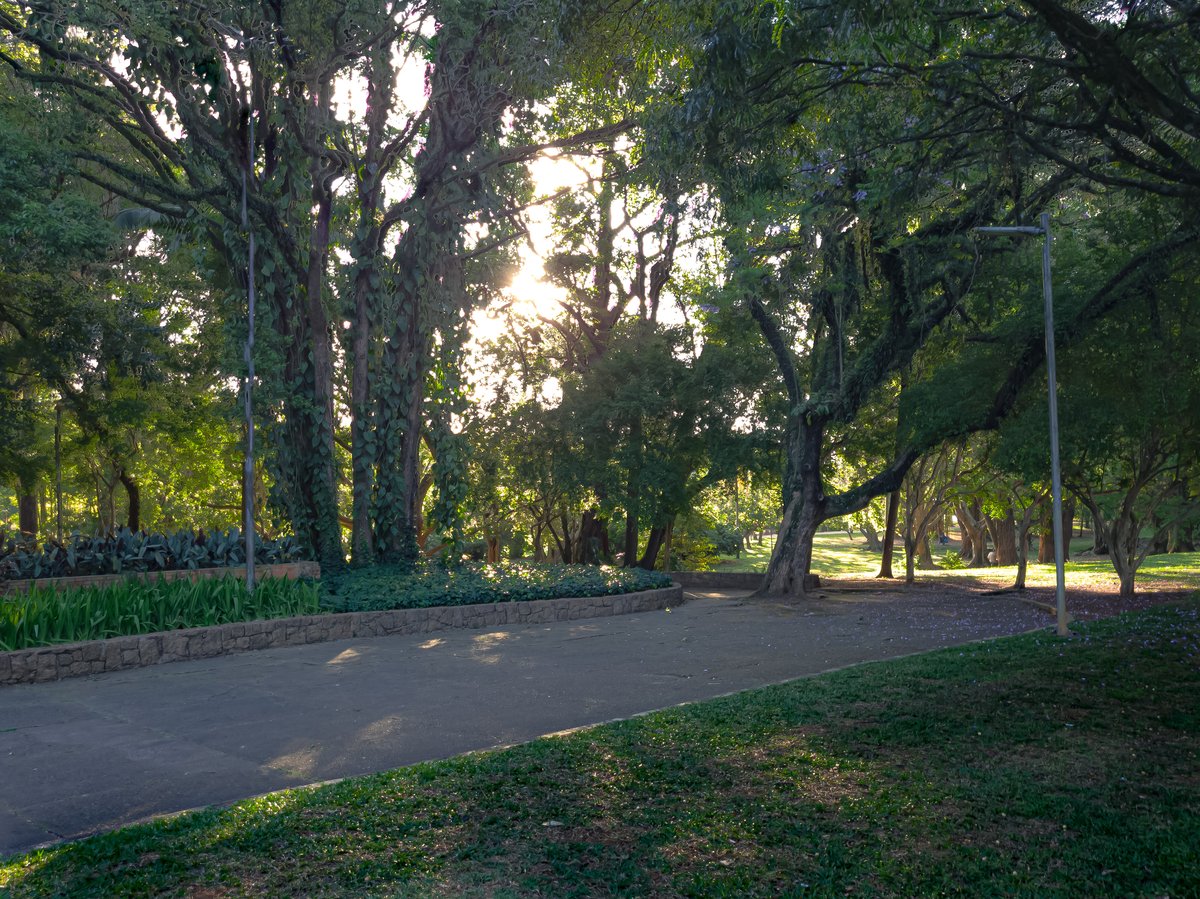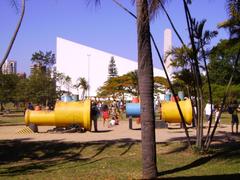
Ibirapuera Park: Visiting Hours, Tickets, and Attractions in São Paulo
Date: 14/06/2025
Introduction: Why Ibirapuera Park is a Must-Visit in São Paulo
In the heart of São Paulo, Ibirapuera Park stands as a landmark of Brazilian modernism, seamlessly integrating cultural heritage with sprawling green landscapes. Established in 1954 to celebrate São Paulo’s 400th anniversary, this vast urban oasis covers nearly 390,000 square meters and showcases the creative genius of architect Oscar Niemeyer and landscape architect Roberto Burle Marx. From world-class museums and iconic modernist structures to tranquil lakes and vibrant public gardens, Ibirapuera Park is an essential destination for architecture enthusiasts, history buffs, nature lovers, and anyone seeking a cultural experience in Brazil’s bustling metropolis (riotimesonline.com; perkinswill.com; saopaulofreewalkingtour.com).
Table of Contents
- Introduction
- Historical Overview
- Architectural and Environmental Significance
- Practical Visitor Information
- Main Attractions and Cultural Institutions
- Activities and Recreation
- Events, Tours, and Photographic Spots
- Frequently Asked Questions (FAQs)
- Final Tips and Resources
- References
Historical Overview
Indigenous Origins
Before its transformation, the land that became Ibirapuera Park was a wetland and home to indigenous villages. The name “Ibirapuera” is derived from the Tupi language, meaning “rotten wood” or “rotten tree,” reflecting its former marshy landscape. Indigenous peoples lived here for centuries, shaping the local ecology and leaving an indelible mark on the area’s heritage (riotimesonline.com).
Park Development and Urban Vision
The concept of a grand urban park emerged in the late 19th century, but it was only realized in the early 1950s as São Paulo prepared for its 400th anniversary. The park was envisioned as both a natural sanctuary and a cultural showcase, intended to rival global urban parks like Central Park in New York (arquitecturaviva.com; worldatlas.com).
Niemeyer and Burle Marx’s Influence
Oscar Niemeyer designed the park’s iconic buildings—including the Bienal Pavilion, Oca, Marquise, and Ibirapuera Auditorium—emphasizing modernist curves and open, communal spaces (nextstopbrazil.com). Roberto Burle Marx landscaped the grounds, blending native Atlantic Forest species with innovative design to create lush, harmonious gardens (urbandesignlab.in).
Architectural and Environmental Significance
Modernist Masterpieces
Ibirapuera Park is a living museum of Brazilian modernism. Key structures include:
- Bienal Pavilion: Host of the São Paulo Art Biennial and other major events.
- Oca: A distinctive domed exhibition space.
- Ibirapuera Auditorium: Famous for its bold design and acoustics.
- Marquise: A sweeping canopy connecting buildings and providing shaded walkways.
These buildings embody Niemeyer’s vision of accessible art and communal gathering, while the landscaping by Burle Marx elevates the park’s environmental value (perkinswill.com; archdaily.com).
Urban Oasis & Biodiversity
The park’s 390,000+ square meters feature lawns, lakes, wooded areas, and gardens supporting over 135 bird species and diverse flora. It serves as the city’s “green lung,” improving air quality, providing habitat for urban wildlife, and offering environmental education through facilities like the Viveiro Manequinho Lopes nursery and UMAPAZ (cbd.int; sdglocalization.org).
Practical Visitor Information
Opening Hours
- Weekdays: 5:00 a.m. to midnight
- Weekends: Open 24 hours
Certain museums and attractions within the park have specific opening hours—check their official websites for details.
Entry Fees
- Park Entry: Free
- Museums and Exhibits: Vary by venue—some offer free admission on select days. Check individual websites for current prices and discounts.
Accessibility
- Wheelchair-accessible paths, ramps, and restrooms
- Family-friendly facilities, including playgrounds
- Bicycle lanes and parking
Getting There
- By Metro: Lines 1 (Blue) and 5 (Lilac) with stations like Brigadeiro, Santa Cruz, Vila Mariana, Ana Rosa, Paraíso, and AACD-Servidor nearby.
- By Bus: Several lines stop at park entrances.
- By Car: Limited parking; arrive early on weekends.
- By Bicycle: Dedicated lanes and racks at main entrances.
Main Attractions and Cultural Institutions
Architectural Landmarks
- Bienal Pavilion (Pavilhão da Bienal): Home to the São Paulo Art Biennial, major exhibitions, and São Paulo Fashion Week (saopaulofreewalkingtour.com).
- Oca do Ibirapuera: Striking dome hosting blockbuster art and science exhibitions (discoverwalks.com).
- Ibirapuera Auditorium: Venue for concerts and festivals.
- Japanese Pavilion: Traditional tea house, art, and serene gardens, reflecting Japanese-Brazilian heritage.
Museums
- Afro Brasil Museum: Explores Black Brazilian history and culture; free entry on Wednesdays.
- Museum of Modern Art (MAM): Brazilian modern art and a sculpture garden; pay-what-you-wish admission.
- Museum of Contemporary Art (MAC-USP): Over 8,000 works, panoramic rooftop views.
- Ibirapuera Planetarium: Brazil’s first planetarium, with immersive shows on weekends.
Natural Highlights
- Lakes and Fountains: Ideal for picnics and birdwatching; nightly fountain show at 6:00 p.m.
- Gardens: Over 500 plant species, shaded lawns, and specialized gardens.
- Sports Facilities: Running/cycling loops, tennis/basketball courts, skatepark, fitness classes.
Monuments
- Obelisk of São Paulo: Memorial to the 1932 Constitutionalist Revolution.
- Public Art: Sculptures and murals, including works by Eduardo Kobra.
Activities and Recreation
- Running, walking, and cycling on dedicated paths
- Yoga and group fitness, especially on weekends
- Skateboarding and playgrounds for families
- Outdoor library and reading areas
- Paddle boating on lakes
Events, Tours, and Photographic Spots
Events
- São Paulo Fashion Week, Biennials of Art and Architecture, music/dance festivals, and seasonal celebrations (bienaldearquitetura.org.br).
Guided Tours
- Available via park visitor centers and local tour operators, focusing on art, architecture, or nature.
Photographic Spots
- Oca Pavilion’s dome
- Marquise walkway
- Lakeside at sunset
- Bienal Pavilion’s curves
- Murals by Eduardo Kobra
Frequently Asked Questions (FAQs)
Q: What are Ibirapuera Park’s opening hours?
A: 5:00 a.m. to midnight on weekdays; 24 hours on weekends.
Q: Is the park free to enter?
A: Yes, though some museums/exhibitions may charge admission.
Q: Are guided tours offered?
A: Yes, via visitor centers and local tour companies.
Q: Is the park accessible for people with disabilities?
A: Yes, with paved paths, ramps, and adapted restrooms.
Q: Can I bring my pet?
A: Yes, but pets must be leashed.
Q: Where are the best spots for photography?
A: Oca Pavilion, Marquise, lakes, and major monuments.
Final Tips and Resources
- When to Visit: Early mornings and weekdays for fewer crowds; weekends for lively events.
- What to Bring: Sunscreen, water, rain gear, and cash for kiosks.
- Navigation: Use offline maps; park maps available at entrances.
- Safety: Keep belongings secure and respect park rules.
- Information: For event schedules, tickets, and guided tours, visit the Ibirapuera Park official website.
For more tips and updates, download the Audiala app and follow park updates on social media.
References
- The Infinite Story of Ibirapuera Park, São Paulo Locals’ Favorite, Riotimesonline
- Oscar Ibirapuera Building, Perkins and Will
- Ibirapuera Park Architecture and Attractions, Saopaulofreewalkingtour
- Ibirapuera Park Official Website, Prefeitura de São Paulo
- Bienal de Arquitetura São Paulo, Official Website
- Oscar Ibirapuera Building, ArchDaily
- Revitalizing São Paulo: The Asymmetrical Harmony of Parque Ibirapuera, Urban Design Lab
- CBD: Cities and Biodiversity in São Paulo
- SDG Localization: São Paulo 2020
- Discoverwalks: Top 10 Facts About Ibirapuera Park




































































































































































